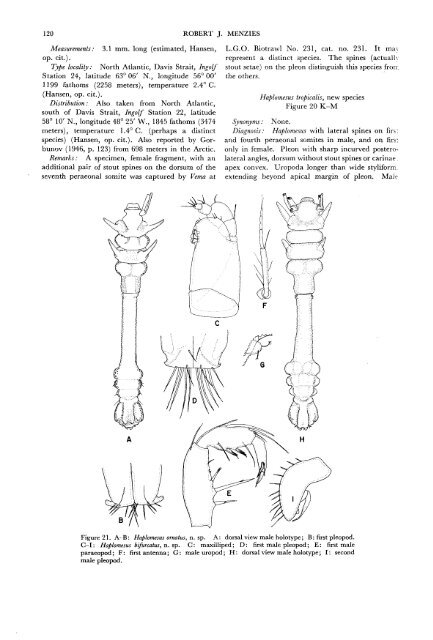The Isopods of Abyssal Depths in the Atlantic Ocean
The Isopods of Abyssal Depths in the Atlantic Ocean
The Isopods of Abyssal Depths in the Atlantic Ocean
You also want an ePaper? Increase the reach of your titles
YUMPU automatically turns print PDFs into web optimized ePapers that Google loves.
120 ROBERT J. MENZIES<br />
Measurements: 3.1 mm. long (estimated, Hansen,<br />
op. cit.).<br />
Type locality: North <strong>Atlantic</strong>, Davis Strait, Ingolf<br />
Station 24, latitude 63° 06' N., longitude 56° 00'<br />
1199 fathoms (2258 meters), temperature 2.4° C.<br />
(Hansen, op. cit.).<br />
Distribution: Also taken from North <strong>Atlantic</strong>,<br />
south <strong>of</strong> Davis Strait, Ingolf Station 22, latitude<br />
58° 10' N., longitude 48° 25' W.; 1845 fathoms (3474<br />
meters), temperature 1.4° C. (perhaps a dist<strong>in</strong>ct<br />
species) (Hansen, op. cit.). Also reported by Gorbunov<br />
(1946, p. 123) from 698 meters <strong>in</strong> <strong>the</strong> Arctic.<br />
Remarks: A specimen, female fragment, with an<br />
additional pair <strong>of</strong> stout sp<strong>in</strong>es on <strong>the</strong> dorsum <strong>of</strong> <strong>the</strong><br />
seventh peraeonal somite was captured by Vema at<br />
L.G.O. Biotrawl No. 231, cat. no. 231. It mav<br />
represent a dist<strong>in</strong>ct species. <strong>The</strong> sp<strong>in</strong>es (actuallv<br />
stout setae) on <strong>the</strong> pleon dist<strong>in</strong>guish this species from<br />
<strong>the</strong> o<strong>the</strong>rs.<br />
Haplomesus tropicalis, new species<br />
Figure 20 K-M<br />
Synonyms: None.<br />
Diagnosis: Haplomesus with lateral sp<strong>in</strong>es on firs:<br />
and fourth peraeonal somites <strong>in</strong> male, and on firs:<br />
only <strong>in</strong> female. Pleon with sharp <strong>in</strong>curved posterolateral<br />
angles, dorsum without stout sp<strong>in</strong>es or car<strong>in</strong>ae<br />
apex convex. Uropoda longer than wide styliform.<br />
extend<strong>in</strong>g beyond apical marg<strong>in</strong> <strong>of</strong> pleon. Male<br />
Figure 21. A-B: Haplomesus ornatus, n. sp. A: dorsal view male holotype; B: first pleopod.<br />
C-I: Haplomesus bifurcatus, n. sp. C: maxilliped; D: first male pleopod; E: first male<br />
paraeopod; F: first antenna; G: maleuropod; Ff: dorsal view male holotype; I: second<br />
male pleopod.

















